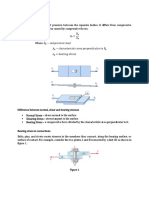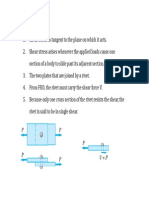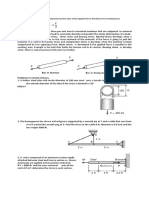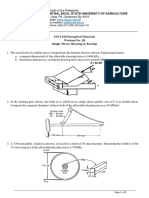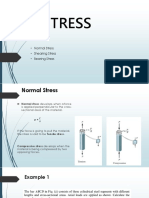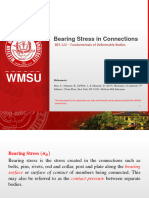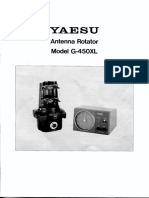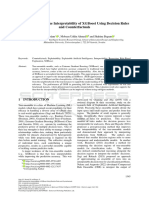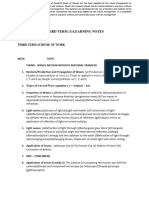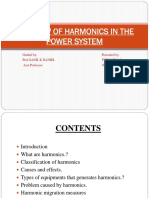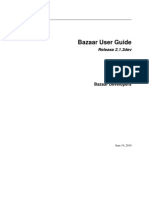BEARING STRESS
Bearing stress is the contact pressure between the separate bodies. It differs from compressive stress, as it
is an internal stress caused by compressive forces.
𝑃𝑏
𝜎𝑏 =
𝐴𝑏
Where:
Pb = compressive or bearing load
Ab = charactersistic area perpendicular to Pb
𝜎b = bearing stress
Difference between normal, shear and bearing stresses
Normal Stress – stress normal to the surface
Shearing Stress – stress tangent to the surface
Bearing Stress – a compressive force divided by the characteristic area perpendicular to it.
Bearing stress in connections
Bolts, pins, and rivets create stresses in the members they connect, along the bearing surface, or
surface of contact. For example, consider the two plates A and B connected by a bolt CD as shown in
figure 1 .
Figure 1
�The bolt exerts on plate A a force P equal and opposite to the force F exerted by the plate on the bolt (Fig.
2). The force P represents the resultant of elementary forces distributed on the inside surface of a half-
cylinder of diameter d and of length t equal to the thickness of the plate.
Figure 2
Since the distribution of these forces—and of the corresponding stresses—is quite complicated, one uses in
practice an average nominal value σb of the stress, called the bearing stress, obtained by dividing the load P
by the area of the rectangle representing the projection of the bolt on the plate section (Figure 3). Since this
area is equal to td, where t is the plate thickness and d the diameter of the bolt, we have
𝑃 𝑃
𝜎= =
𝐴 𝑡𝑑
Figure 3
�SAMPLE PROBLEMS:
1. In the figure, assume that a 20-mm-diameter rivet joins the plates that are each 110 mm wide. The
allowable stresses are 120 MPa for bearing in the plate material and 60 MPa for shearing of rivet.
Determine (a) the minimum thickness of each plate; and (b) the largest average tensile stress in the plates.
�2. The lap joint shown in the figure is fastened by four 3⁄4-in.-diameter rivets. Calculate the maximum safe
load P that can be applied if the shearing stress in the rivets is limited to 14 ksi and the bearing stress in the
plates is limited to 18 ksi. Assume the applied load is uniformly distributed among the four rivets.
Given:
Diameter of each rivet = 3⁄4 inch
Maximum allowable shear stress of rivet = 14 ksi
Maximum allowable bearing stress of plate = 18 ksi
Required: The maximum safe value of P that can be applied
3. In the clevis shown in the figure, find the minimum bolt diameter and the minimum thickness of each
yoke that will support a load P = 14 kips without exceeding a shearing stress of 12 ksi and a bearing stress
of 20 ksi.
�4. A 7/8-in.-diameter bolt, having a diameter at the root of the threads of 0.731 in., is used to fasten two
timbers together as shown in the figure. The nut is tightened to cause a tensile stress of 18 ksi in the bolt.
Compute the shearing stress in the head of the bolt and in the threads. Also, determine the outside
diameter of the washers if their inside diameter is 9/8 in. and the bearing stress is limited to 800 psi.
��5. Figure below shows a roof truss and the detail of the riveted connection at joint B. Using allowable
stresses of τ = 70 MPa and 𝜎𝒃 = 140 MPa, how many 19-mm-diameter rivets are required to fasten member
BC to the gusset plate? Member BE?
